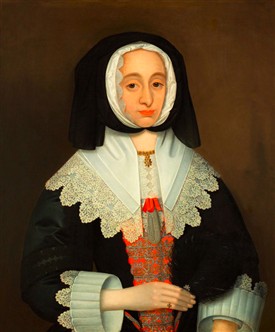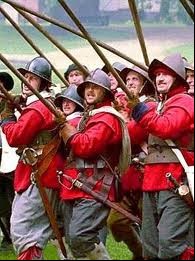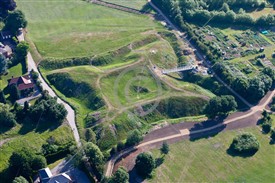Lucy Hutchinson on the English Civil War

Lucy Hutchinson
1620 - 1681

Civil War at Newark

Newark: Queen's Sconce
Local Events of the seventeenth-century conflict seen through the writings of the wife of a governor of Nottingham of the time
By ROGER PEACOCK
The English Civil War in Nottinghamshire: an account from the writings of Lucy Hutchinson.
Report of a talk given to the Newark Archaeological & Local History Society, Wednesday 3rd April 2013
The speaker on this occasion was Valerie Henstock. Her talk was based on Lucy’s journal, compiled at the time, and on her later memoirs of the life of her husband Colonel John Hutchinson. Both form an invaluable record of the seventeenth century conflict between Parliamentary forces, governed by Oliver Cromwell, and Royalists loyal to the cause of King Charles I.
Colonel Hutchinson was of Parliamentarian sympathy, being the appointed governor of Nottingham, a town which upheld the Cromwellian cause. Lucy, however, a well-educated and intelligent lady, whose portrait suggests purity and victory, would no doubt have held some social affinity with many who supported the Royalist cause. Her husband, born the son of Nottinghamshire M.P. Sir Thomas Hutchinson, had been brought up by members of the Byron family owing to his father's early death. Sir Richard Byron served as governor of the traditionally-Royalist township of Newark. Byron's influence played a large part in the defence of Newark, the town where King Charles took refuge during the Civil War, and where three sieges were imposed upon the town before the King's final capitulation.
Lucy Hutchinson's writings were and are regarded with authority, although there is no doubt that her account takes a bias towards her husband's status; she sought to enhance his reputation. She saw herself as answerable to God, to her espoused, and to herself.
Born in 1620, Lucy was married in 1638. The marital home was in Owthorpe, Nottinghamshire. Because husband and wife were actually of the Baptist tradition, records of their offspring – possibly as many as twenty-two in number - are vague, since their denomination did not practise infant christenings. It can only be said that their churchmanship encouraged equality and democratic rights regardless of gender or social position. Worship in Owthorpe Church was informal rather than rigidly liturgical.
It must be admitted, Mrs. Henstock said, that there was much variation by local sub-cultural groups in whether to support the Royalist (Cavalier) or Parliamentarian (Roundhead) cause, at least privately. John Hutchinson, having accepted the task of building up Nottingham Castle's defences on behalf of the latter, found it difficult to do so to the satisfaction of the townspeople. St. Nicholas' Church, near the centre of the town, was a structural vantage-point for Royalist intrusion and observation, and this was far too near Nottingham Castle, the main Parliamentary stronghold. It must be remembered that at that time, Nottingham Castle was a castle, a fortress at the top of a strategic hill overlooking the town, and not the mansion house that later replaced it. It should be borne in mind, too, that Nottingham, like Newark, was far smaller in those days, and less densely-populated. Trent Bridge, and the area since called The Meadows, provided key fortress positions for the Roundheads. Lucy Hutchinson, in her journal, recounts sporadic surges of guerilla warfare, and several colourful and gory skirmishes by this entrance to the town. Newark, meanwhile, was a safe haven for royalists, one in which Queen Henrietta Maria took refuge in 1643, and one in which King Charles took up residence as he travelled northwards to meet the opposition. Much of Newark's central architecture bears witness to the period of the English Civil War. [1] The Trent, and Newark's own Trent Bridge, also provided a boundary of security, but in this case, unlike Nottingham, the castle stood alongside both, the physical geography of the land affording a northwards view of some miles. The Trent Valley is remarkably flat, and the Castle had high towers and turrets. Parliamentarian attacks took place from the periphery of the town, but its defences, the two sconces and the (then upbuilt) Newark Castle, were able to stave off the initial onslaught. Besides the town itself, there were other outcrops of Cavalier loyalty in the rural environment. Places such as Shelford and Belvoir Castle provided points of communication. An attack on Shelford, recorded in Lucy’s memoirs of her husband, suggests a vivid pandemonium.
The sieges of Newark proved bitter and prolonged. Records in Upton Church proclaim the difficulties experienced by the locals as a result of these sieges. Owing to the lack of sanitation and supplies, disease broke out in 1646, adding to the misery and destitution of the townspeople. In the end, King Charles fled from the Roundhead march and assault, but, seeing that he stood no chance of upholding any authority or power, surrendered to the Parliamentarian forces at Southwell, and called upon Newarkers to give up the struggle. Following this, the king, effectively deposed, was put on trial for treason against the government and the land. Found guilty, he was condemned to execution by beheading. To the end, he upheld the argument that he owned his throne by the divine right of God, but it was to no avail. His sentence took place, the first-ever republican government of England was set up and placed under Cromwell's protectorship, and most of Newark Castle was dismantled to leave the ruins that are listed for conservation to this day.
As for Colonel John Hutchinson: after the Puritan victory, Oliver Cromwell applauded him for his support in the conflict, and offered a position of authority, a governorship in the new r égime. Hutchinson, however, chose to decline this. One assumes that he continued to serve the Parliamentarian cause for the next decade. In 1660 came the Restoration of the Crown to England; King Charles II ascended the throne. A number of prominent Parliamentarian supporters were placed on a death list by those loyal Crown supporters, John Hutchinson, however, survived any such threats, but was placed under arrest from Newark. He later died at Sandown, Kent. His remains were taken to Owthorpe Church. There, in the crypt of the Church, he received a Christian burial. A monument was erected by his wife in his memory and embellished with a poetic paen of his life, also written by her.
Lucy Hutchinson's memoirs record all this, but tell us little of her own career preferring to concentrate on her husband’s role. She died in 1681, and was buried in the crypt at Owthorpe beside her husband John.
Mrs. Henstock's account was brief and concise, and provided an interesting background to an important period of local history, particularly so for Newark.
© Roger Peacock for NALHS: 13th April 2013
Edited by Valerie Henstock: 15th April 2013